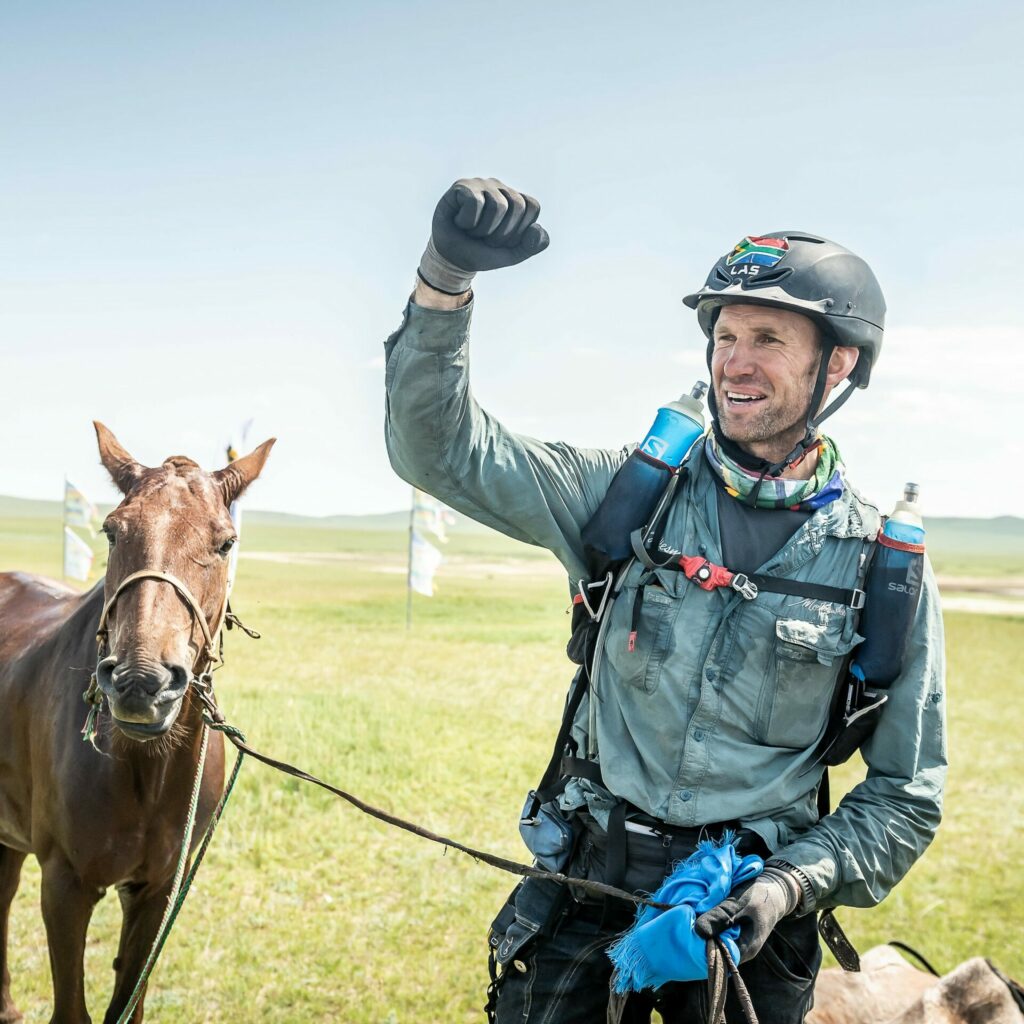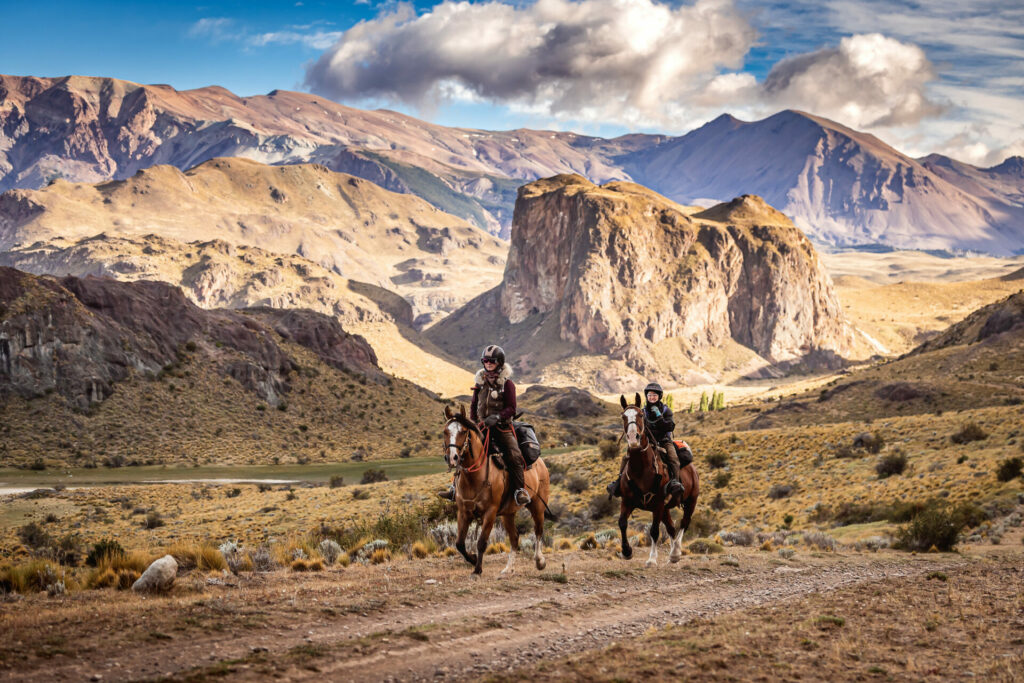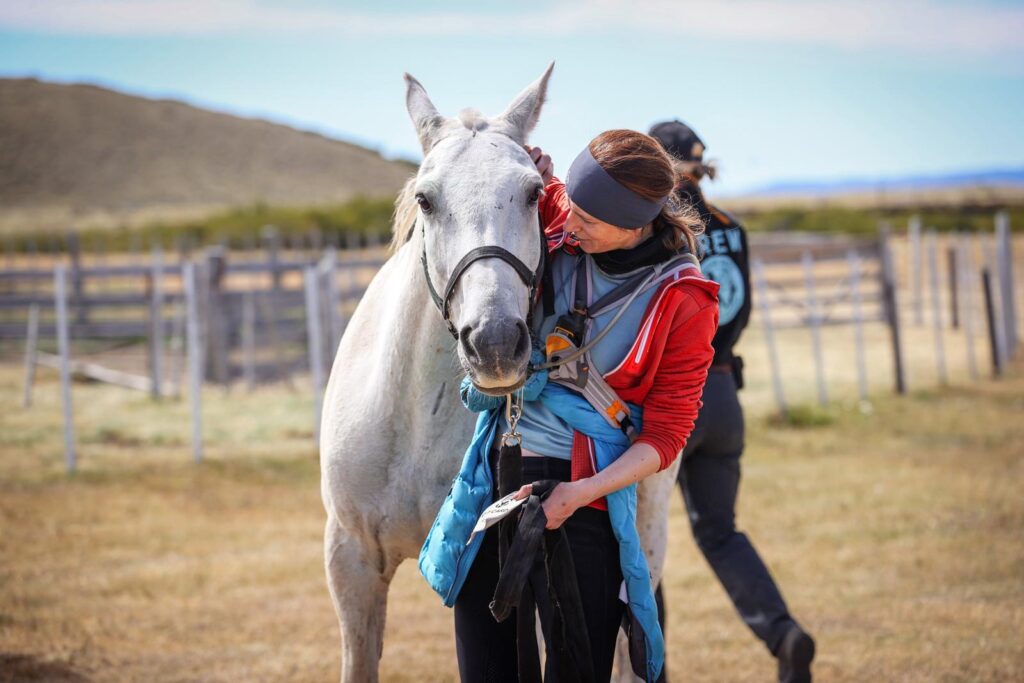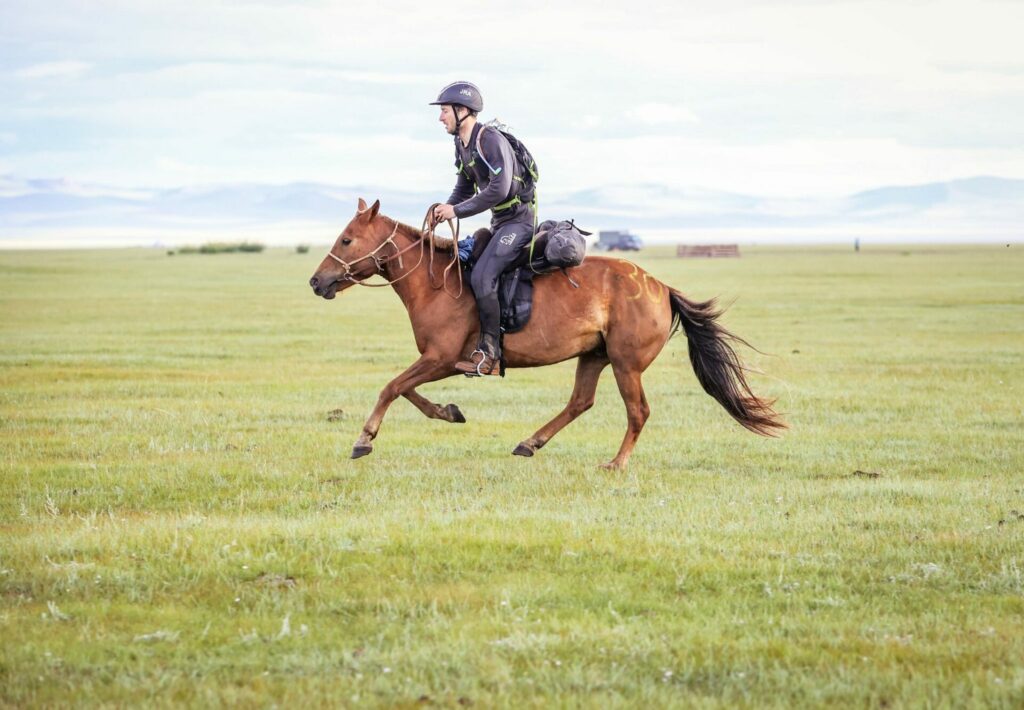Catch up with the Gaucho Derby 22 Winners
The Gaucho Derby is one of the toughest horse races on the planet and last month concluded the first full scale running of the beast. Riders tackled everything wild the Andes could throw at them from biblical winds of 80+kms per hour, high mountains, snow and some pretty unlovely bogs. It is a race unlike any other on the planet, rooted in the folklore of the Gaucho and their lifestyle. To compete in it requires some serious skill and tenacity, to win it…well join us now as we catch up with our joint winners Anna Boden and Holly Conyers (both from the UK).
What was the best bit of the whole thing?
Holly: “Very hard to pick, but one of the most memorable moments for me was when we finally reached the summit of the Patagonian Mount Doom above the finish line after schlepping up there on foot for what felt like forever, and suddenly Fitzroy appeared in front of us. That view beggars belief: you just can’t believe it’s real. Both of us just burst out laughing, standing there in hysterics staring at it for a good few minutes.”
Anna: “When we came around the corner to the final horse change having made a navigational decision to go along the river and we realised that we were in the lead. We saw a black horse similar to Holly Chamberlain’s outside the corral and for a moment we thought, “bugger, the other 3 are ahead of us”, but then we realised that the black horse we saw had a cropped tail while Holly’s had a full length tail. Such highs and lows!”
Who was your favourite horse and why?
Holly: “To be honest most of mine were cracking so it’s hard to pick, but the horse that I got at VC6 was such a hero. Embarrassingly, I called him Teddy after my childhood rocking horse (still the only horse I have ever actually owned). He was very spritely when I got him out of the corral so I thought he was going to be a bit of a challenge, but once I was on board he was an absolute star. Anna had an opinionated horse that leg who really resented moving forwards unless glued to something else’s bum, so mine had to do all the front running and was just so easy. He carried or followed me up and down some ludicrously trappy and steep ground through the woods and across the rivers without hesitation, and was so clever across the boggy sections that caught a lot of others out: I just gave him his head and he would flatten the plants beside the bogs to walk over them.”
Anna: “I have two. Firstly, my horse I picked at VC11 at Lago San Martin. He looked just like my best friend’s horse from back home, a small chestnut. He was not the typical Argentine stamp of horse, but he knew his job and got on with it. I genuinely just put him into autopilot and he didn’t stop. The other was my last horse and an old brute! He tried to buck me off at least 4 times and I could not steer him but only because he knew exactly where to go. The horses had been herded in the opposite direction along the same route the previous day.”
How was riding as a team with each other? How did that dynamic work?
Holly: “I don’t think we ever actually explicitly decided to ride as a team: we just agreed to ride out of VC2 together on the second morning and from then on we were joined at the hip, even when we were in bigger groups. When Anna wasn’t berating me for my tardiness in the mornings, we rubbed along well together because we’re both very no-nonsense and were very honest with each other the whole way round. There was no drama or bickering, even when Anna made a fair attempt at running me over with my own horse. When we made a decision, if it turned out to be the wrong one we never blamed each other and just got on with fixing it, which I think was really important.”
Anna: “We were very frank with each other the whole time. We are both not afraid to speak up if we felt something, we just confronted it which is what I think is very important.”
Tell us about camping out with the horses and your teammates, what was the most memorable night?
Anna: “My second horse was seriously good in his hobbles so night 2 was pretty memorable. He broke his lead-rope and I woke up several times in the night to hear him thudding away. That night was also memorable because we had NO WATER. We had left the last vet check in a rush at 5.50 and knew we could camp by the lake but the lake water was seriously muddy. Lesson learned! I also loved the race hold night…an asado and lots of wine was exactly what we needed after falling 1.5 hours behind the leaders.”
Holly: “My favourite night camping out was probably our last one, because by that point I was so tired I actually slept for longer than an hour at a time despite the howling gales, and had been gifted a hip flask full of whisky. On a serious note though, we were marooned on a little haven of boggy grass beside a river in an otherwise totally rocky valley just below the ridge line, so it was about as remote as you could get. The stars up there were so bright you didn’t need a torch to get up in the night to check the horses. Which was handy as there was absolutely nothing to tie the horses to up there other than rocks, from which mine swiftly perfected escaping despite also being hobbled. He had crippling FOMO whenever anyone else took their horse to water so made a few breaks for the river, but would just tie himself in knots and resort to whinnying until I appeared to rescue him.”
How was Argentina?
Holly: “Argentina makes life in the UK feel quite constrained. I first came to Patagonia 7 years ago for a few months and fell madly in love with it then. Last September I quit my City law job in London, moved back here in November before the race and am yet to return to the UK. I love the freedom of Patagonia. Everyone is so welcoming, open and relaxed, and fond of a party. Luckily the concept of health and safety has not yet reached Patagonian horse culture, which makes the whole thing just wildly good fun and a bit of a contrast to some aspects of riding in the UK. Speaking passable Argentine Spanish was a great advantage for me too, as all the gauchos and estancia owners were so keen to chat everything horsey and wanted to know how the race was going. I even acquired a pair of reins and a head-collar at start camp from a gaucho who was impressed by my chamamé skills.”
Anna: “Brits are very stiff upper lipped and quick to judge. However, in Patagonia, everyone took you for face value. Also, the Gauchos were beyond welcoming. Great competitors combined with amazing locals made for the best atmosphere ever. It felt like we were all in it together. It was just more about the experience than the winning.”
How did you prepare/train for the race?
Anna: “I ran a lot. Probably 2 or 3 half marathons a week. I also did 6 hours riding round the British countryside in the saddle nonstop twice a week at least.”
Holly: “I was pretty lucky in that I have been working on an estancia in Patagonia since November with loads of different horses to ride, so I spent a lot of time in the saddle alone, gauchoing or guiding. I also scrambled up a lot of hills, and camped out alone with a horse to practise with my saddle bags and hobbling.”
How was it riding in a group?
Anna: “A group is mentally quite hard work. Because we were at the front most of the way, we were with the most competitive bunch. Therefore having lots of points of views on directions was a given. To start with, because I had horses that wouldn’t go in front, I just kept out of any decisions. If there was a disagreement about directions it wasn’t as easy as just splitting up because horses are pack animals. Therefore, the front runners had to all stick together. Then, there is the other element of trying to split up and get away at checkpoints…which is difficult. Even if we got ahead by 10 or 15 minutes it didn’t matter because the horses behind would want to catch up to the horses in front. If there was an open grassland area, the horses behind can see the horses in front and then they are just on autopilot. It’s so much harder riding in front for both you and the horse because you’re making decisions and the horses are expending much more energy in being brave. Therefore, whatever lead you make leaving a checkpoint is always going to be very difficult to maintain.”
Holly: “Groups are great until a decision has to be made. The larger the group, the longer any decision will take because everyone has an opinion. That becomes costly in a race like this, especially when you’re at the front. There are no tracks for you so every time you come to an obstacle of some sort you have to work it out for yourself, but those behind you can just follow your tracks. It means they actually have quite an advantage coming behind you, as they have to stop less to think about what to do next. Leading is a big physical and mental strain. We didn’t really ride in a group bigger than 5 people at any one stage, and to be honest that was already too big, but it’s really hard to get away from the front. We only pulled it off on the last day by taking a big navigational risk and taking a totally different path from the others.”
How was it navigating during the race?
Anna: “It’s so funny, when we first got the map there was a huge amount of route analysis from all competitors. However, no matter how much you think you’ve got a plan, when you get to the area and you see the landscape, it is TOTALLY different. But that was great because it meant that you had to think on the spot and we were all challenged equally.”
Holly: “I got a bit of a fright at the hotel in Calafate when everyone vanished to their rooms to feverishly consult Google Earth and plot additional points into their GPS the night before we left. My attitude was basically to have a rough plan based on the map, use the GPS to make sure you’re not going too far wrong, and ride what’s actually in front of you. You could also have the best plotted GPS route in the world, only to be scuppered by the total lack of a gate in the never ending fence-line. Anna and I also shared the navigating duties a bit, in that she would have the GPS out while I checked the map or vice versa.”
How do you view the whole thing now you’re finished?
Anna: “The race teaches you so much about yourself. I am often really worried about what people think of me and always want to please others (which is obviously generally a good thing but sometimes it’s very detrimental). However, in the race like environment, if you are competitive like me, you cannot afford to continually be nice and look after others…it’s a race after all. Anyway, I learned that I had to be true to myself and work out what I actually wanted to get out of the race. It has also made me crave new and exciting situations even more. The monotony of London just doesn’t appeal to me anymore. It used to seem freeing and exciting but at that point, I hadn’t been to Patagonia. You meet so many incredible people who are so free spirited and nomadic, just like you, so it makes you want to just travel and meet new people forever and ever. The Gaucho Derby is an experience of a lifetime, more than just a race, and I am only sad that I can never do it again for the first time. How can the boring day to day life of a job ever be as fulfilling? It just can’t!”
Holly: “It has given me a confidence in my own judgement and abilities which I didn’t have before, especially to do with all things outdoors and horses. I knew I had a lot of useful experience, but I have never really done anything competitive with horses at all so lining up beside so many very qualified riders was a bit daunting. The only moments I regretted in the race were when I let somebody else in the group make a decision which my gut told me was wrong, but I didn’t back myself enough to make my own call and it ended up taking us off track. I wouldn’t do that again: it’s taught me to always, always trust my own instincts. Even if you’re wrong, you can’t regret a decision you made entirely on your own.
Also, as those who know me well will attest, I have not historically been the biggest fan of working in teams. I planned to ride alone, but I honestly don’t think I could have done this without Anna. A huge part of why we won is that we stuck together through the highs and the lows. We physically could not have made up the time we did on the Plateau of Death without each other: our horses hated being led and a decent chunk of the terrain required being on foot, so I made Anna lead them from the front while I flapped about behind them making a lot of noise. Those riding ahead of us didn’t think to try it. It sounds corny but it really has made me appreciate the value of teamwork, even when your teammate informs you “you’re doing a SHIT job Holly”, and her horse then kicks you in agreement.
Doing this race was a bit of a leap of faith for me as it coincided with quitting my job and moving across continents. That choice definitely resulted in some raised eyebrows back home, at a time when most of my friends are acquiring fiancés and/or puppies. It took a while to build up the courage to do it, but there hasn’t been a single second I regretted my decision. The race was the most incredible experience alongside some fascinating people, and I genuinely loved every second of it. The whole experience has reinforced to me the importance of getting out of your comfort zone and testing your boundaries: I didn’t really have any clue if I would actually be capable of any of this until I just put myself out there and did it, but I will always be so glad I did.”
Day 5 and the action heats up
As the race enters Day 5, the competition at the front has heated up. Gaucho Derby veteran Daniel Van Eden, Endurance Athlete Holly Masson and Mongol Derby veteran Rendel Rieckmann, have managed to secure the lead so far. Their excellent horsemanship, careful navigation and teamwork across the course has allowed them to pull in front.
Read moreAnd they’re off
Yesterday after a few delays the riders stormed off the line and into the wilderness of Patagonia...
Read more



